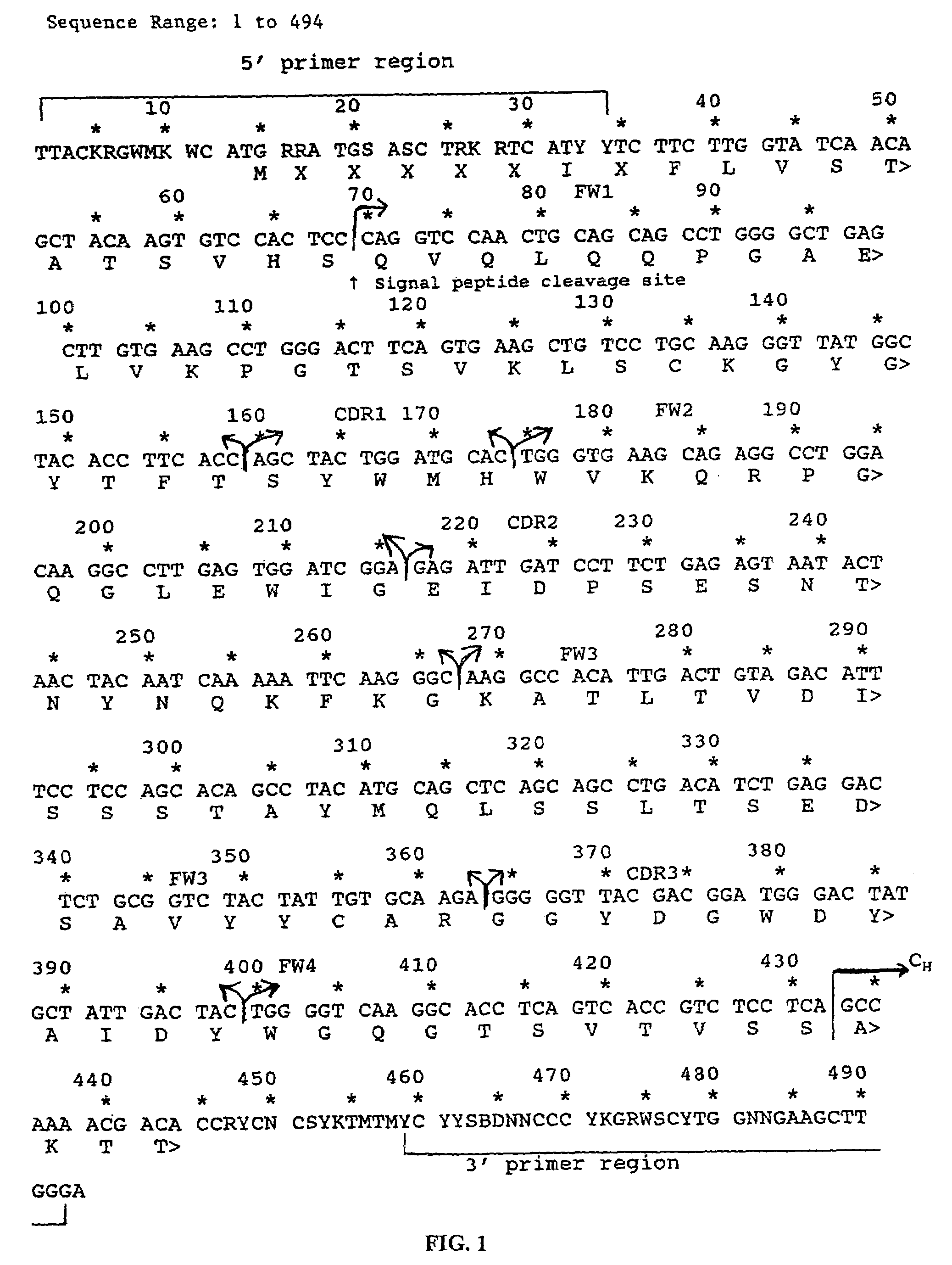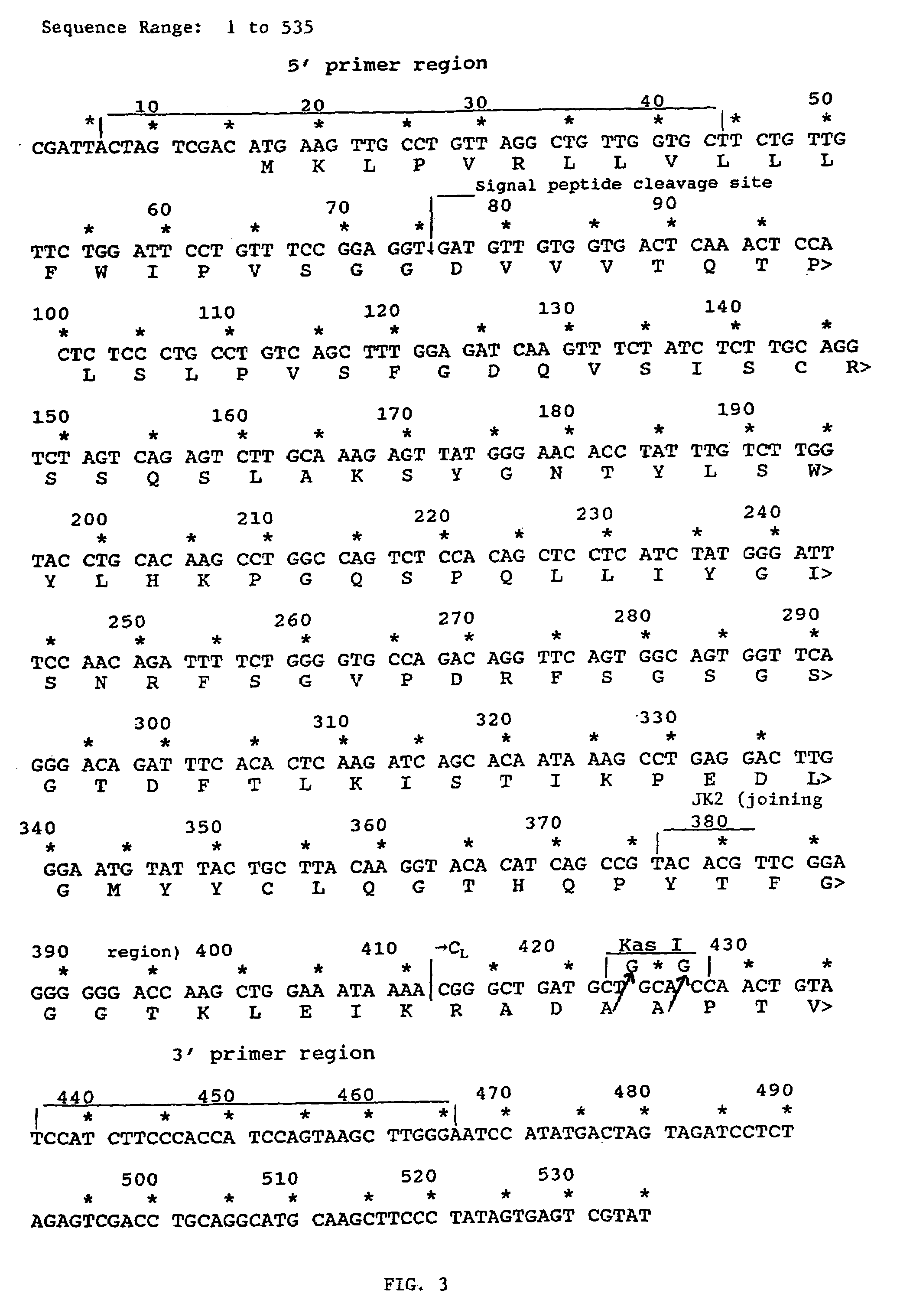Humanized immunoglobulin reactive with α4β7 integrin
a humanized immunoglobulin and integrin technology, applied in the field of humanized immunoglobulin reactive with 47 integrin, can solve the problems of reducing the efficacy of mouse antibody in patients, limiting any therapeutic benefit, and continuing administration, and achieve the effect of reducing inflammatory responses
- Summary
- Abstract
- Description
- Claims
- Application Information
AI Technical Summary
Benefits of technology
Problems solved by technology
Method used
Image
Examples
example 1
Cloning of Act-1 VH and VL Regions, and Construction and Expression of a Murine-Human Act-1 Chimeric Immunoglobulin
Cloning of Act-1 VH and VL Regions
[0081]RNA was obtained from hybridoma cells which produce Act-1 monoclonal antibody (Lazarovits, A. I. et al., J. Immunol., 133(4): 1857–1862 (1984); provided by A. I. Lazarovits and R. B. Colvin)) using TRIzol Reagent (Gibco / BRL) following the manufacturer's suggested protocol.
[0082]Transcribed heavy and light chain variable regions were amplified by polymerase chain reaction (PCR) using an Ig-Prime kit (Novagen) according to the maufacturer's suggested protocol. Briefly, 1.5 μg of total RNA was reverse transcribed to cDNA in a reaction containing 2.0 μl 5× MMLV Buffer (5×=250 mM Tris-HCl, pH 8.3 at 25° C., 375 mM KCl, 15 mM MgCl2), 1.0 μl 100 mM DTT (dithiothreitol), 0.5 μl 10 mM dNTP mix (10 mM each DATP, dCTP, dTTP, dGTP), 0.5 μl oligo dT (1 μg / μl), 0.25 μl acetylated BSA (4 mg / ml), 1.0 μl of appropriate Ig-3′ primer (10 pmol / μl), 0...
example 2
Molecular Modelling of the Mouse Act-1 Variable Regions
[0128]In order to assist in the design of the CDR-grafted variable regions, a molecular model of the mouse Act-1 variable regions was produced. Modeling the structures of well-characterized protein families with immunoglobulins was done using the established methods for modeling by homology. Molecular modeling was carried out using a Silicon Graphics IRIS 4D workstation running under the UNIX operating system, the molecular modelling package QUANTA (Polygen Corp., Waltham, Mass.), and the Brookhaven crystallographic database of solved protein structures. As a first step, the framework regions (FRs) of the new variable regions were modeled on FRs from similar, structurally-solved immunoglobulin variable regions. While identical amino acid side chains were kept in their original orientation, mutated side chains were substituted using the maximum overlap procedure to maintain chi angles as in the original mouse Act-1 antibody. Most...
example 3
Construction of Nucleic Acids Encoding Reshaped Variable Regions
[0158]After confirming that the correct heavy chain and light chain variable regions had been cloned biochemically (partial amino acid sequence) and functionally (chimeric antibody staining of HuT 78 cells), a reshaped amino acid sequence was designed as described above. Next, genes encoding the reshaped antibody chains were designed and prepared.
Design, Construction, and Expression of Humanized ACT-1
[0159]After determining the primary amino acid sequence of the humanized antibody as described in Example 2, the sequence was reverse-translated into a degenerate nucleic acid sequence and analyzed for potential restriction enzyme sites using Macvector (Kodak, Scientific Imaging Systems) version 4.5.3. A nucleic acid sequence was then selected which incorporated restriction enzyme cleavage sites but conserved the primary amino acid sequence. The heavy chain nucleic acid sequence (SEQ ID NO:18) and amino acid sequence (SEQ I...
PUM
| Property | Measurement | Unit |
|---|---|---|
| total volume | aaaaa | aaaaa |
| total volume | aaaaa | aaaaa |
| total volume | aaaaa | aaaaa |
Abstract
Description
Claims
Application Information
 Login to View More
Login to View More - R&D
- Intellectual Property
- Life Sciences
- Materials
- Tech Scout
- Unparalleled Data Quality
- Higher Quality Content
- 60% Fewer Hallucinations
Browse by: Latest US Patents, China's latest patents, Technical Efficacy Thesaurus, Application Domain, Technology Topic, Popular Technical Reports.
© 2025 PatSnap. All rights reserved.Legal|Privacy policy|Modern Slavery Act Transparency Statement|Sitemap|About US| Contact US: help@patsnap.com



